Sedum album is a dense, creeping succulent that is sometimes referred to as White Stonecrop. It grows up to four inches tall and approximately 18 inches wide. It is a widespread plant that is native to Europe, western Asia, and North Africa.
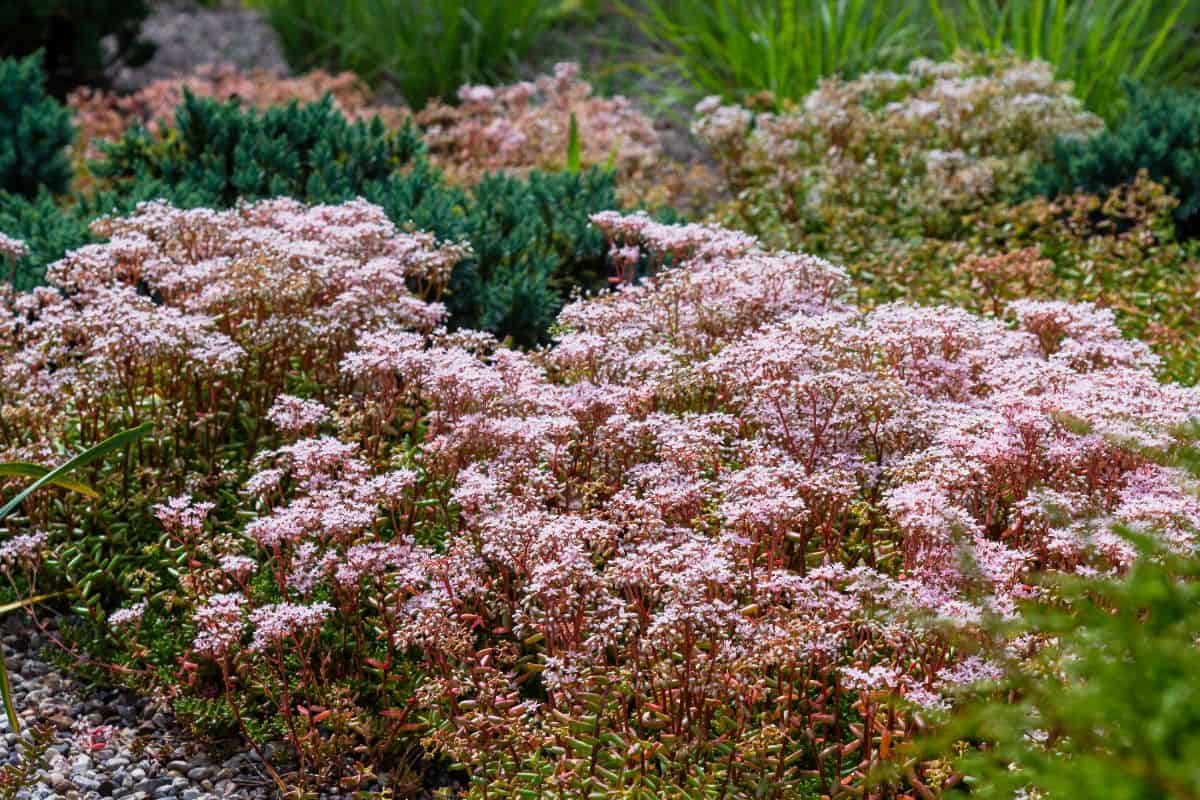
White Stonecrop is a hardy plant that is suitable for both beginner and experienced gardeners. This is a low-maintenance plant that needs little attention or care.
Sedum is one of the few freeze-resistant succulents, so they’re suitable for growing outdoors in a wider range of climates than most succulents. Their hardiness and adaptability also make these plants ideal for growing in outdoor spaces that are not hospitable enough for other types of outdoor plants.
Jump to:
Description
| Name: | Sedum album |
| Soil: | Well-drained soil |
| Blooming: | Mid to late Summer |
| Light: | Full sun |
| Water: | When the soil is dry |
| Propagation: | Cuttings, offsets and seeds |
The leaves of White Stonecrop are small, oblong, and either cylindrical or slightly flattened. They are green in color, but often turn a reddish-brown shade during the fall and winter. This reddish hue can also be brought on by stress due to direct sunlight and drought.
In mid-summer, you can expect White Stonecrop to bloom. Petite, white, star-shaped flowers are produced in clusters high above the plant’s foliage.
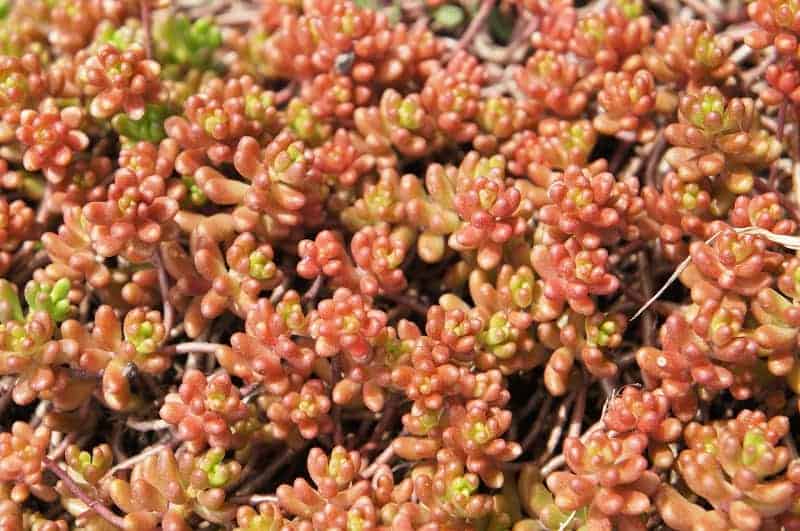
Stonecrops have a reputation as one of the most versatile succulents. It is a relatively fast-growing plant compared to other types of succulents and is incredibly easy to propagate.
It’s also non-toxic to pets, so you won’t need to worry about your furry friends if they accidentally ingest a leaf or two.
Cultivars
If White Stonecrop doesn’t provide the pop of color you’re looking for, look no further than Sedum album ‘Coral Carpet’. On this cultivar of Sedum album, new growth is coral or salmon-pink in color and matures to vibrant green color. In winter, the color changes to a reddish-brown.
The flowers of Coral Carpet Stonecrop may be either white or pale pink. As with White Stonecrop, the blooms are produced in clusters above the plant’s foliage.
Care
As previously mentioned, White Stonecrop is a low-maintenance succulent that can easily be grown indoors or outdoors. Regardless of how much succulent caretaking experience you have, Sedum album is likely to thrive, as long as you provide some basic care.
As with most succulents, White Stonecrop does best when grown with a hands-off approach to gardening. Too much attention or water and your Stonecrop is probably going to suffer.
Light
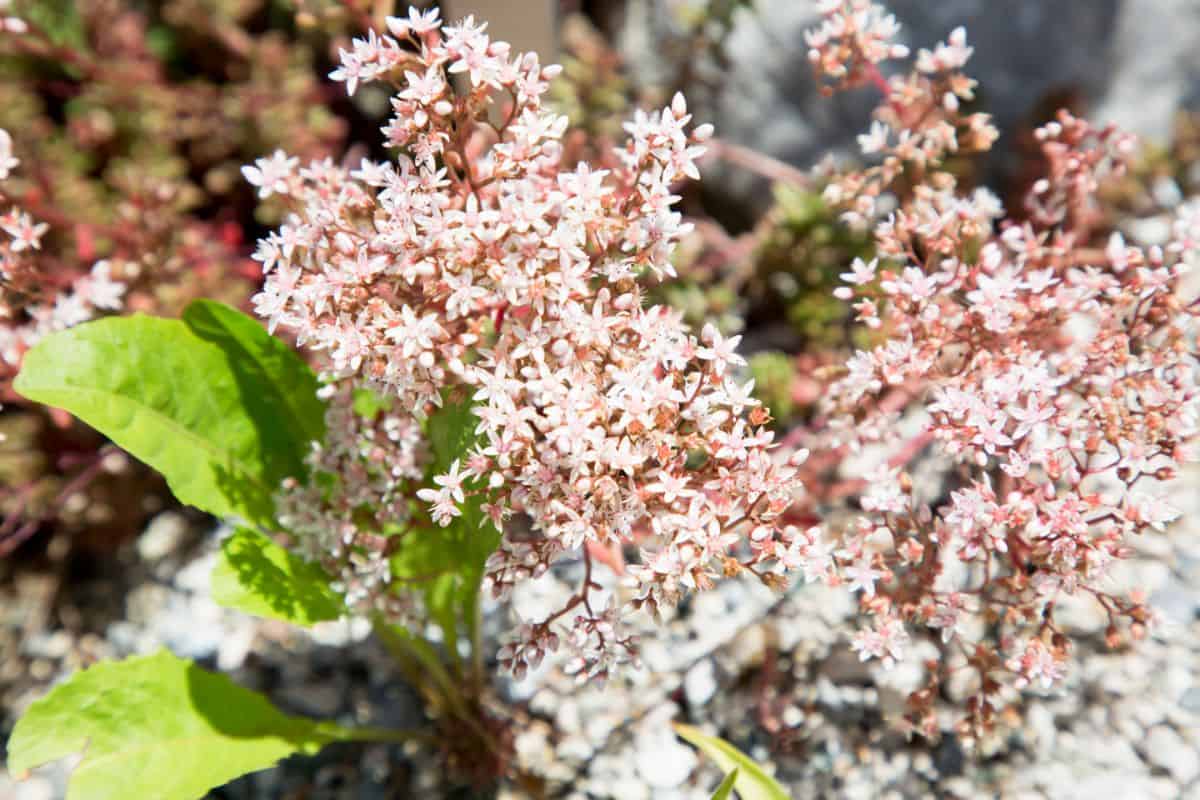
White Stonecrop loves sunlight, so be prepared to place this plant in your brightest window. South-facing windows are ideal, but bright west- or east-facing windows will work well too.
No products found.
Sedum album doesn’t do well in low-light environments. It will lose its vibrant color and will begin to appear stretched out or etiolated. Once this occurs, the plant’s original appearance cannot be restored.
If your Sedum becomes etiolated, the best step to take is to behead your beloved succulent and plant the cuttings to be grown in a brighter area.
If you suspect your indoor space can’t provide enough light for your White Stonecrop, you should consider investing in a grow light. Full-spectrum grows lights are relatively inexpensive and will provide your precious plants with everything they need to grow despite their lack of natural sunlight.
When grown outdoors, Sedum album does best in full sun. Direct sunlight will also cause the plant to flush red with stress, which will add a unique splash of color to your garden.
Although White Stonecrop does best in full sun, if you’ve just picked your plants up from the nursery or are moving them outside after a life indoors, you’ll need to adjust their sunlight slowly to prevent sunburn.
Like etiolation, sunburn causes permanent damage and though a little sunburn it won’t harm your plants, it doesn’t look very pretty. The only option is to wait until new growth replaces the burnt leaves and stems, or trim away the damaged parts.
To prevent sunburn, allow your Sedum to slowly adapt to increased light over a period of several weeks. By increasing the light incrementally every few days, you allow the plant time to adjust without risking sunburn.
Water
Sedum album is drought tolerant succulents that are capable of handling up to several months of drought if necessary. Like sun stress, drought can also bring out Stonecrop’s most vibrant colors, so if that’s your goal, consider cutting back your plants’ water a bit.
Like most succulents, Sedum’s worst enemy is overwatering. Overly wet soil will eventually cause the roots to begin rotting, so be sure to check the moisture in the soil before you water.
You can use a soil moisture meter if you choose, or you can test the soil’s moisture levels by inserting your finger into the soil a few inches. If the soil feels moist, wait a few days before watering. If the soil feels dry to the touch, it’s safe to water.
If your Stonecrop’s roots do begin to rot, you probably won’t see any signs until it’s too late. Root rot is a sneaky disease that causes a lot of damage below the surface long before it makes its presence known up top.
Once root rot has begun moving up your Stonecrop’s stem, its chances of survival are quite slim. You can always try beheading it to save part of the plant, but you need to be certain that the rot hasn’t progressed that far up the stem.
White Stonecrop will grow well regardless of the humidity in the air. If you live in a particularly humid climate, you may need to wait longer between watering. Dry climates will cause more moisture to evaporate, so you’ll need to water more frequently.
Temperature
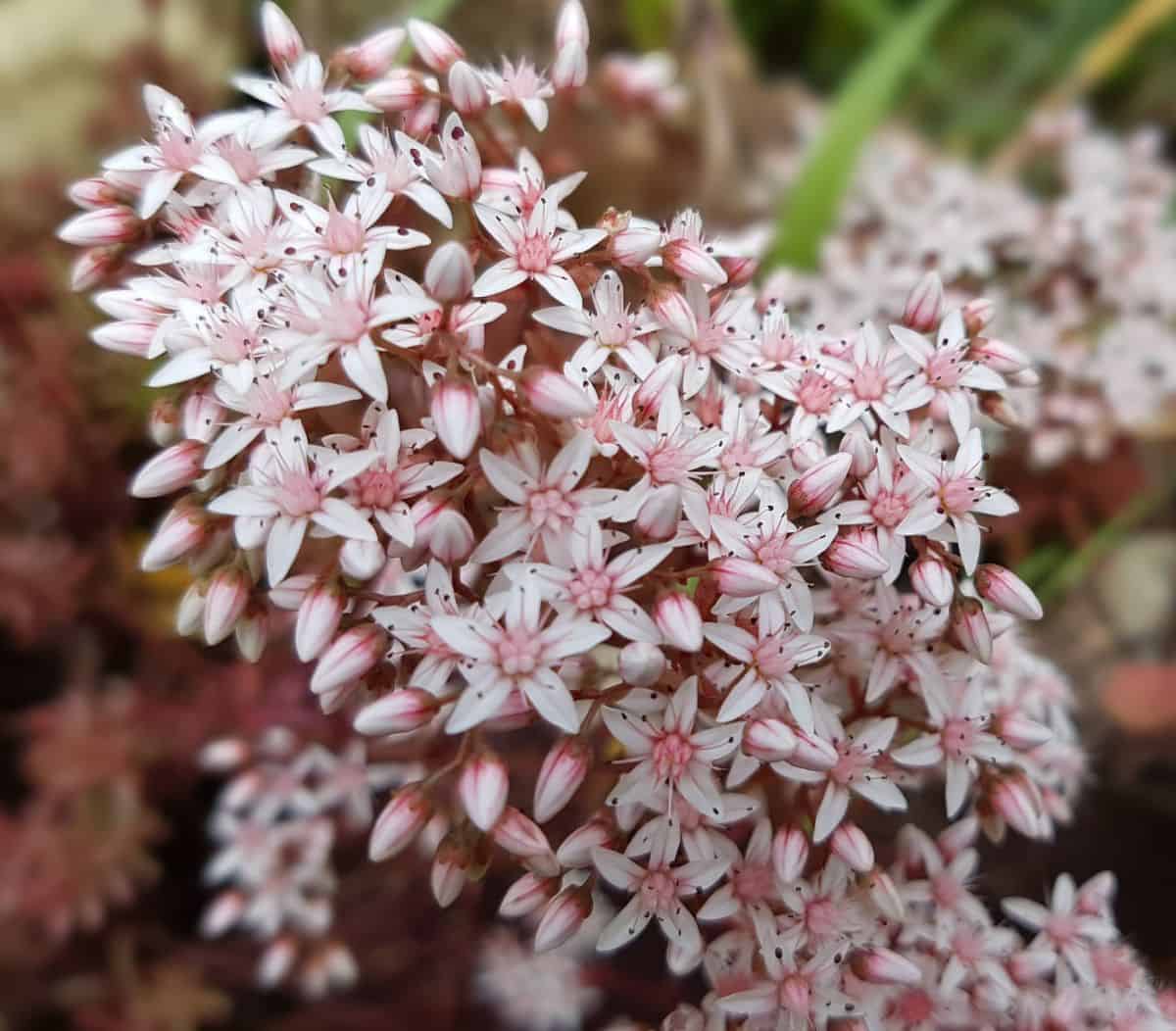
White Stonecrop prefers warmer temperatures and can also tolerate extreme heat. It’s also one of the few succulents that can survive freezing temperatures. This hardy plant can survive temperatures as low as -30 degrees Fahrenheit.
Sedum experience dormancy during winter, which helps them to survive harsh winter weather. During this time, there is very little active growth, so watering can also be adjusted when the frigid weather of winter sets it.
Soil
Sedum album requires well-draining soil, but it’s capable of adapting to a variety of different soil types. That is, just as long as the soil doesn’t retain too much water.
If you aren’t the DIY type, commercial cactus or succulent soil will be fine for White Stonecrops. Any soil that contains large particles of coarse sand, gravel, perlite, or even bark will provide the necessary drainage and airflow.
It’s important to avoid using commercial soil mixtures that contain a lot of water-retaining ingredients such as clay, peat moss, or coconut coir. Soil with these types of ingredients will lead to overwatering and root rot.
If you’re growing Stonecrop indoors, it’s important to choose a pot with a drainage hole to provide an exit for excess moisture. Having the right soil is crucial, but it won’t make a difference if the extra water can’t escape the pot.
If your White Stonecrop is planted outdoors, drainage is still important, even you don’t grow it in containers. Raised beds or berms are ideal for outdoor succulents as they promote drainage. Of course, you’ll still need to make sure you’re planting your Sedum in the right soil.
Propagation
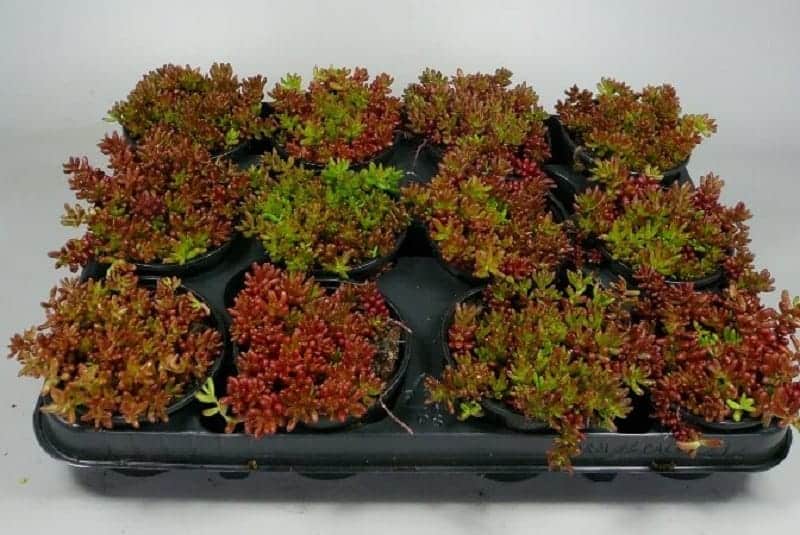
Sedum album is a great succulent for gardeners inexperienced with propagation to practice on. It can be propagated with a variety of different methods including seeds, stem or leaf cuttings, and offsets.
As a faster-growing species of succulent, Sedum album can establish new plants relatively quickly. This means with a little propagation your garden will be full of Stonecrop and you’ll even have enough to give to your friends and family as gifts.
See Related Article: Echeveria Purpusorum - A Care Guide
Leaf and Stem Cuttings
White Stonecrop can be propagated using either stem or leaf cuttings. This is generally the most popular method of propagation as it requires little effort or skill. Propagating Stonecrop cuttings is a simple process for inexperienced and expert gardeners alike.
To take a cutting from your White Stonecrop, be sure you’re using a sharp and sterile knife or pair of scissors or shears. Sharp, clean tools minimize damage to your plants and give your cuttings a better chance of survival.
If you’re interested in propagating leaf cuttings, use the tool of your choice to cut off a few leaves. The next step is to leave the cuttings alone for a few days to allow the cuts to callous, which will help prevent infection and increase their chances of survival.
For stem cuttings, the process is basically the same. Cut a portion of the stem off and allow the cuttings to dry for a few days. If your Sedum collection is quite overgrown, you may be able to take quite a few cuttings to propagate.
Once your cuttings have calloused, you can place them in soil. It will take a few weeks for them to grow roots. During these first few weeks, you don’t really need to water your cuttings as they don’t have roots to absorb moisture anyway.
Once the first few tiny roots appear, you can begin watering your Stonecrop cuttings more normally. It’s okay for the cuttings to be a bit damper than mature plants but be sure to avoid standing water or overly wet soil.
After a few weeks, you’ll have established Stonecrops that you can treat just as you would the rest of your collection.
Seeds
Growing Sedum album from seeds is not for the impatient gardener, but it can be a fun and interesting way to propagate your favorite plants. Seeds are readily available on the internet, or you can try collecting them yourself from your blooming Stonecrops.
Offsets
Offset division is another simple method of Sedum album propagation. Just remember that it’s recommended to cut away the offsets as close to the mother plant as you can. This way, you’ll take as much of the offset’s existing root system as possible.
Again, when removing offsets, you want to use a clean, sharp knife or pair of scissors or shears. Many gardeners find knives to be the best tool for this job as it requires less room to maneuver around in the soil near your Stonecrop’s delicate roots.
Just as you would with a leaf or stem cuttings, you want to give the offsets a couple of days to callous before planting to protect them from potential infection.
Once you have the offsets planted in their new container or new outdoor area, you can treat them just as you would a mature Stonecrop. These petite plants already have roots and are ready for life on their own, so they don’t need any special care.
Common Pests and Problems
As you may have read before, the most common problem growers experience with White Stonecrop is overwatering. Stonecrops are hardy plants that can tolerate a lot of mistakes, but consistent overwatering will result in the death of your succulent.
No matter how often you water your Sedum album, be sure to check the soil using a soil moisture meter or your finger before watering. This way, you put off watering for a few more days if the soil is already sufficiently moist. This should be done with both indoor and outdoor plants.
Sadly, Sedum album is not immune to pests. Though it can tolerate a lot of challenging conditions, it is just as vulnerable to pests as any other succulent. Common succulent pests include fungus gnats, mealybugs, spider mites, and scale.
The specific pests your Stonecrop is at risk of being infested by may vary according to where you live. Though most common succulent pests are found around the world, there are some that vary by location.
The best way to prevent pest infestations is to make sure your plants are clean, and the soil is clear of any decaying plant material. Overly wet soil is also an invitation for insects, so be sure to water your succulent only as often as it requires.
You should also avoid placing new plants among your current collection until they’ve gone through a quarantine period of at least two weeks. By keeping new plants in a separate area, you limit the chance of an infestation spreading to all of your succulents. It’s much easier to treat a new plant or two for pests than it is to treat your entire home or garden.


